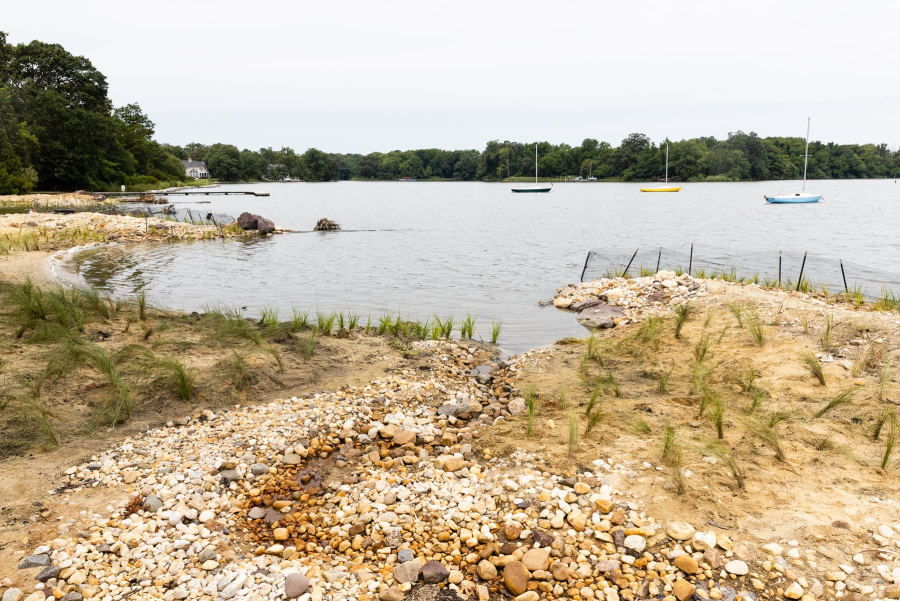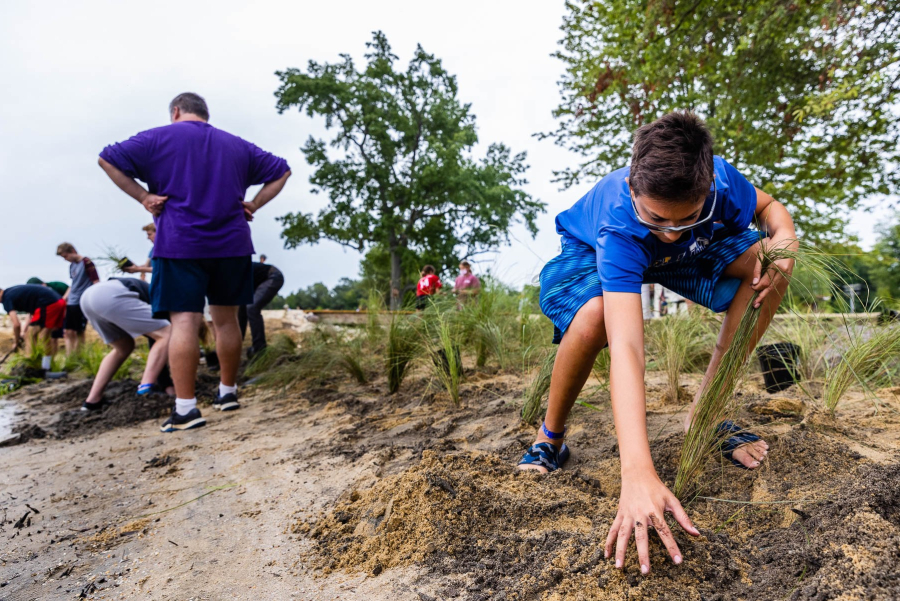Faith-based recreation center off the Chesapeake Bay gets nearly 900 feet of healthy shoreline
Maryland DNR funds the living shoreline through its climate resiliency initiative

Since 2021, a restored shoreline outside the West River United Methodist Center has been embracing the high tides of the Chesapeake Bay with relative ease.
When storms roll through, the water is slowed down by strategically placed breakwaters extending from the shoreline. As the water progresses, it soaks into grassy wetlands that reduce flooding and keep the beach intact. On a sunny day, community members can enjoy the shoreline and observe the varying degrees of wildlife—another beneficiary of the project.
Prior to the 885-feet of shoreline being put in place, there was essentially no beach to speak of.
Instead, a wooden bulkhead separated the West River from the Center’s lawn. Over the years, the water began to flow over the bulkhead and flood the property. Stormwater runoff from behind the center would build up along the bulkhead when it rained.
“Something was going to need to happen with [the] bulkhead,” said Chris Schlieckert, the center’s director of Retreat and Camping Ministries.
Schlieckert now calls the project a “win-win.” The bulkhead was removed and replaced with a shoreline that not only protects against erosion, but treats stormwater runoff coming from the roads and parking lot behind the center. Wetland grasses absorb the water on both sides, while a series of “step pools” upland of the beach manage all the stormwater. The shoreline also includes a long cobble structure that slows down waves and keeps the grasses in place.
“Primarily, we're trying to put practices in place that use nature to help reduce erosion and flood impacts to the [Center],” said Nicole Carlozo, section chief, Waterfront and Resource Planning at Maryland Department of Natural Resources (DNR).
Maryland DNR was a main funder of the project and contributed to the shoreline design through its Resiliency Through Restoration Initiative. The initiative provides support for design, construction and management of restoration projects where the focus is to be more resilient to the impacts of climate change.

Over the years, many waterfront property owners along the Bay and its tributaries have turned to living shorelines to help with erosion, flooding and stormwater management. Environmental experts argue that natural shorelines are just as good at handling these issues as man-made bulkheads and riprap. These “green” solutions also provide a wide variety of wildlife habitat that the “gray” features never could.
Before applying for the Maryland DNR’s resiliency initiative grant, the Center teamed up with the Annapolis-based Alliance for the Chesapeake Bay (Alliance). The Alliance applied for the resiliency initiative grant on behalf of the Center. They also secured additional funding from the Chesapeake Bay Trust for the step pool stormwater management. The Center won both grants and was picked as the pilot project for Maryland’s resiliency initiative, in part because of the site’s many visitors.
“They have about 10,000 visitors per year, which provided a unique opportunity to integrate a living shoreline project into existing education programs,” said Carlozo.
Maryland DNR funded much of the project and contributed to the designs of the shoreline, while the Alliance took over management. The Alliance, a 53-year-old nonprofit that works on a watershed-scale, managed the grants, helped acquire the permits, created a maintenance plan and hired the eventual contractor, Underwood & Associates, to construct the shoreline, wetland and stormwater control.
While the planning process for living shorelines took several years, the actual construction was relatively quick. It took Underwood & Associates just two months to take out the bulkhead and construct the new shoreline, and they did it during the off season.
“When it comes to living shorelines, the actual construction is the fastest part,” said Laura Todd, one of the project’s managers with the Alliance for the Chesapeake Bay.
With the shoreline now in place, the Center integrates the habitat into summer camps, helping young people understand their connection to the water. Guests who use the Center for retreats and other events can also enjoy the beach and learn about its benefits.
Additionally, Maryland DNR uses the space to demonstrate living shorelines to other people who are interested in the program. Through the resiliency initiative, the state agency currently has 18 projects in various stages of development. According to Carlozo, Maryland DNR received 32 proposals for fiscal year 2025, the most they’ve ever received.
Whether it’s funded through Maryland DNR’s program or another related grant, shoreline restoration is helping to add habitat back to the Bay, fend off rising water levels and give people better access to the water.
“This project made nearly 1,000 feet of shoreline accessible when it had not been before,” said Schilieckert. “I would absolutely encourage others to do similar projects.”

Comments
There are no comments.
Thank you!
Your comment has been received. Before it can be published, the comment will be reviewed by our team to ensure it adheres with our rules of engagement.
Back to recent stories